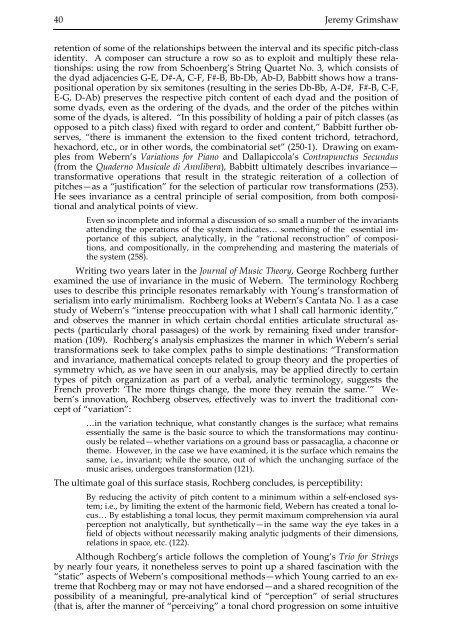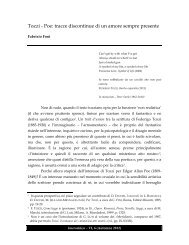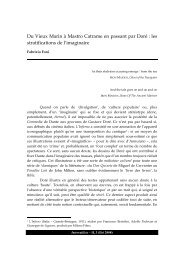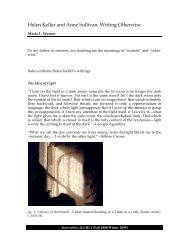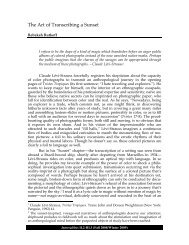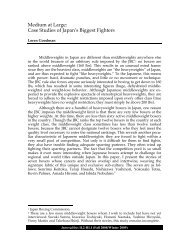The Tabula (not so) Rasa: La Monte Young's Serial Works ... - Cipa
The Tabula (not so) Rasa: La Monte Young's Serial Works ... - Cipa
The Tabula (not so) Rasa: La Monte Young's Serial Works ... - Cipa
You also want an ePaper? Increase the reach of your titles
YUMPU automatically turns print PDFs into web optimized ePapers that Google loves.
40 Jeremy Grimshaw<br />
retention of <strong>so</strong>me of the relationships between the interval and its specific pitch-class<br />
identity. A composer can structure a row <strong>so</strong> as to exploit and multiply these relationships:<br />
using the row from Schoenberg’s String Quartet No. 3, which consists of<br />
the dyad adjacencies G-E, D#-A, C-F, F#-B, Bb-Db, Ab-D, Babbitt shows how a transpositional<br />
operation by six semitones (resulting in the series Db-Bb, A-D#, F#-B, C-F,<br />
E-G, D-Ab) preserves the respective pitch content of each dyad and the position of<br />
<strong>so</strong>me dyads, even as the ordering of the dyads, and the order of the pitches within<br />
<strong>so</strong>me of the dyads, is altered. “In this possibility of holding a pair of pitch classes (as<br />
opposed to a pitch class) fixed with regard to order and content,” Babbitt further observes,<br />
“there is immanent the extension to the fixed content trichord, tetrachord,<br />
hexachord, etc., or in other words, the combinatorial set” (250-1). Drawing on examples<br />
from Webern’s Variations for Piano and Dallapiccola’s Contrapunctus Secundus<br />
(from the Quaderno Musicale di Annlibera), Babbitt ultimately describes invariance—<br />
transformative operations that result in the strategic reiteration of a collection of<br />
pitches—as a “justification” for the selection of particular row transformations (253).<br />
He sees invariance as a central principle of serial composition, from both compositional<br />
and analytical points of view.<br />
Even <strong>so</strong> incomplete and informal a discussion of <strong>so</strong> small a number of the invariants<br />
attending the operations of the system indicates… <strong>so</strong>mething of the essential importance<br />
of this subject, analytically, in the “rational reconstruction” of compositions,<br />
and compositionally, in the comprehending and mastering the materials of<br />
the system (258).<br />
Writing two years later in the Journal of Music <strong>The</strong>ory, George Rochberg further<br />
examined the use of invariance in the music of Webern. <strong>The</strong> terminology Rochberg<br />
uses to describe this principle re<strong>so</strong>nates remarkably with Young’s transformation of<br />
serialism into early minimalism. Rochberg looks at Webern’s Cantata No. 1 as a case<br />
study of Webern’s “intense preoccupation with what I shall call harmonic identity,”<br />
and observes the manner in which certain chordal entities articulate structural aspects<br />
(particularly choral passages) of the work by remaining fixed under transformation<br />
(109). Rochberg’s analysis emphasizes the manner in which Webern’s serial<br />
transformations seek to take complex paths to simple destinations: “Transformation<br />
and invariance, mathematical concepts related to group theory and the properties of<br />
symmetry which, as we have seen in our analysis, may be applied directly to certain<br />
types of pitch organization as part of a verbal, analytic terminology, suggests the<br />
French proverb: ‘<strong>The</strong> more things change, the more they remain the same.’” Webern’s<br />
innovation, Rochberg observes, effectively was to invert the traditional concept<br />
of “variation”:<br />
…in the variation technique, what constantly changes is the surface; what remains<br />
essentially the same is the basic <strong>so</strong>urce to which the transformations may continuously<br />
be related—whether variations on a ground bass or passacaglia, a chaconne or<br />
theme. However, in the case we have examined, it is the surface which remains the<br />
same, i.e., invariant; while the <strong>so</strong>urce, out of which the unchanging surface of the<br />
music arises, undergoes transformation (121).<br />
<strong>The</strong> ultimate goal of this surface stasis, Rochberg concludes, is perceptibility:<br />
By reducing the activity of pitch content to a minimum within a self-enclosed system;<br />
i.e., by limiting the extent of the harmonic field, Webern has created a tonal locus…<br />
By establishing a tonal locus, they permit maximum comprehension via aural<br />
perception <strong>not</strong> analytically, but synthetically—in the same way the eye takes in a<br />
field of objects without necessarily making analytic judgments of their dimensions,<br />
relations in space, etc. (122).<br />
Although Rochberg’s article follows the completion of Young’s Trio for Strings<br />
by nearly four years, it nonetheless serves to point up a shared fascination with the<br />
“static” aspects of Webern’s compositional methods—which Young carried to an extreme<br />
that Rochberg may or may <strong>not</strong> have endorsed—and a shared recognition of the<br />
possibility of a meaningful, pre-analytical kind of “perception” of serial structures<br />
(that is, after the manner of “perceiving” a tonal chord progression on <strong>so</strong>me intuitive


